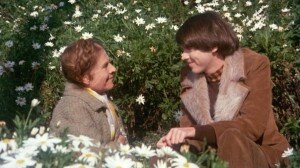Editor’s Spotlight: Harold and Maude (1971)
This being the inaugural article for a new column, some explanation is in order. Editor’s Spotlight for Arts & Entertainment is meant to delve into film history and select a film from the past that an editor sees as valuable or remarkable in some way.
This week, I have chosen a film that deeply affected me and my film sensibility, directed by Hal Ashby, a director who embodies the image of the playful counter-culture filmmakers of the 70s. The film, of course, is Harold and Maude. A typical reaction I encounter when discussing the film is, “isn’t that the movie with the 20 year-old guy in love with the old lady – that’s gross.” Yes, it is.
Harold and Maude is one of those films that suffers from a simple plot summary; it must be experienced. It is film built around opposites, the most obvious being the 60 year age difference between the lovers. However, the couple is also separated by class and belief systems. Harold is a morose lad who comes from extreme wealth, with a self- involved mother (a deliciously deadpan Vivian Pickles) as his only family. Obsessed with death, Harold stages increasingly elaborate fake suicide tableaus, both in a futile attempt to get his mother’s attention, but also, it seems, to fill his days, as he has no job and no friends.
His only other hobby is attending funerals, which is where he meets Maude, a daffy octogenarian, whose electric yellow umbrella sticks out like a sore thumb among the hordes of mourners dressed in black. Initially disturbed by the interest the lively old woman takes with him, Harold is soon attracted to Maude’s openness and rambunctious spirit. They spend many long afternoons and evenings together, sharing stories from their lives, and Harold’s guardedness is slowly chipped away.
The categorization of this film as a “romantic comedy” is almost laughable in this modern age of studio rom-coms that hold the feelings of their characters at arms length. Everything about Harold and Maude is intimate, most of all the experience of the two titular characters. Hal Ashby isn’t making fun of Harold or Maude. Their problems aren’t ironized or belittled.
When the film first premiered in 1971, critics didn’t know what to make of it, or the actors’ performances, which were usually dismissed as being “too quirky” or “too weird.” With his ashen complexion and cherubic face, Bud Cort as Harold is, by turns, wonderfully under-expressive and devilishly impish. As Maude, Ruth Gordon is the very embodiment of life, crackling with zany energy and revolutionary spirit.
Harold and Maude was only Hal Ashby’s second film, and crafts it with such mastery and confidence, always walking a fine line between black humor and heart. It is visually poetic, and moves effortlessly back and forth from moments of hilarity to tragedy. The comedic moments are some of the funniest ever captured on screen, especially the scene where Harold’s mother answers a dating questionnaire for him while he pretends to shoot her and then himself. There is also a subtly hilarious running joke which involves Harold always being dressed identically to his shrink.
The tragic moments are heartbreaking, and greatly aided by Cat Steven’s original songs, the most famous being, “If You Want to Sing Out, Sing Out,” but also the devastating, “Trouble,” which is used in the final sequence of the film.
Of all of the films that occupy my list of favorites, Harold and Maude is perhaps the one I return to the most often. It’s touching romance and comedic spirit make it film that is extremely enjoyable on multiple viewings. One of the original taglines sums the film up perfectly: “They will defy everything you’ve ever seen or heard about screen lovers.”



